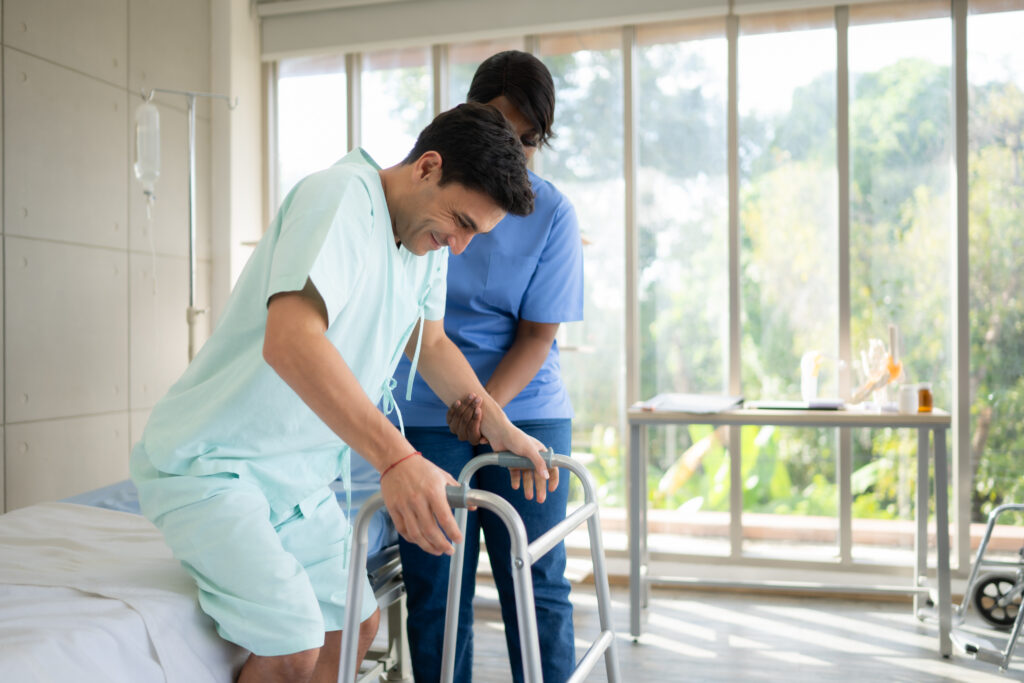
Post-surgical Rehabilitation is a critical phase of the recovery process following various orthopedic procedures. Rehabilitation programs are tailored to the specific joint involved many joints such as –
- Hip & Knee
- Shoulder
- Elbow
- Ankle
The therapies have the primary goals of restoring function, reducing pain, and improving quality of life.
- Hip & Knee Surgery:
- Total Hip Replacement (THR) and Total Knee Replacement (TKR): Post-surgical rehabilitation focuses on early mobility, strengthening the hip or knee, and improving joint range of motion. Exercises, gait training, and pain management techniques are integral components of the program.
- Arthroscopic Knee Surgery: Rehabilitation after procedures like meniscus repair or ACL reconstruction aims to restore knee stability, enhance muscle strength, and gradually return to sports or regular activities.
- Total Hip Replacement (THR) and Total Knee Replacement (TKR): Post-surgical rehabilitation focuses on early mobility, strengthening the hip or knee, and improving joint range of motion. Exercises, gait training, and pain management techniques are integral components of the program.
- Shoulder Surgery:
- Rotator Cuff Repair: Post-surgical rehabilitation emphasizes gentle shoulder exercises, stretching, and strengthening to promote healing and regain full shoulder range of motion and strength.
- Shoulder Arthroplasty (Total Shoulder Replacement): Rehabilitation includes exercises to restore shoulder function and stability, as well as pain management strategies to ease discomfort during the recovery process.
- Rotator Cuff Repair: Post-surgical rehabilitation emphasizes gentle shoulder exercises, stretching, and strengthening to promote healing and regain full shoulder range of motion and strength.
- Elbow Surgery:
- Tennis Elbow or Golfer’s Elbow Surgery: Rehabilitation focuses on exercises to regain strength and flexibility in the forearm and elbow, often incorporating techniques like eccentric strengthening and bracing.
- Tennis Elbow or Golfer’s Elbow Surgery: Rehabilitation focuses on exercises to regain strength and flexibility in the forearm and elbow, often incorporating techniques like eccentric strengthening and bracing.
- Ankle Surgery:
- Ankle Ligament Repair or Reconstruction: Post-surgical rehabilitation centers on restoring ankle stability and mobility. It typically involves exercises for strengthening the ankle muscles, balance training, and gradual weight-bearing activities.
- Ankle Ligament Repair or Reconstruction: Post-surgical rehabilitation centers on restoring ankle stability and mobility. It typically involves exercises for strengthening the ankle muscles, balance training, and gradual weight-bearing activities.
In all post-surgical cases, the rehabilitation process is highly individualized. We work closely with patients to set realistic goals and develop a personalized treatment plan. Progress is monitored, and adjustments are made as needed to ensure optimal recovery. Education about proper home exercises, pain management, and injury prevention is also provided. The ultimate aim is to facilitate a safe and successful return to daily activities, sports, or work, depending on the patient’s unique needs and surgical procedure.
